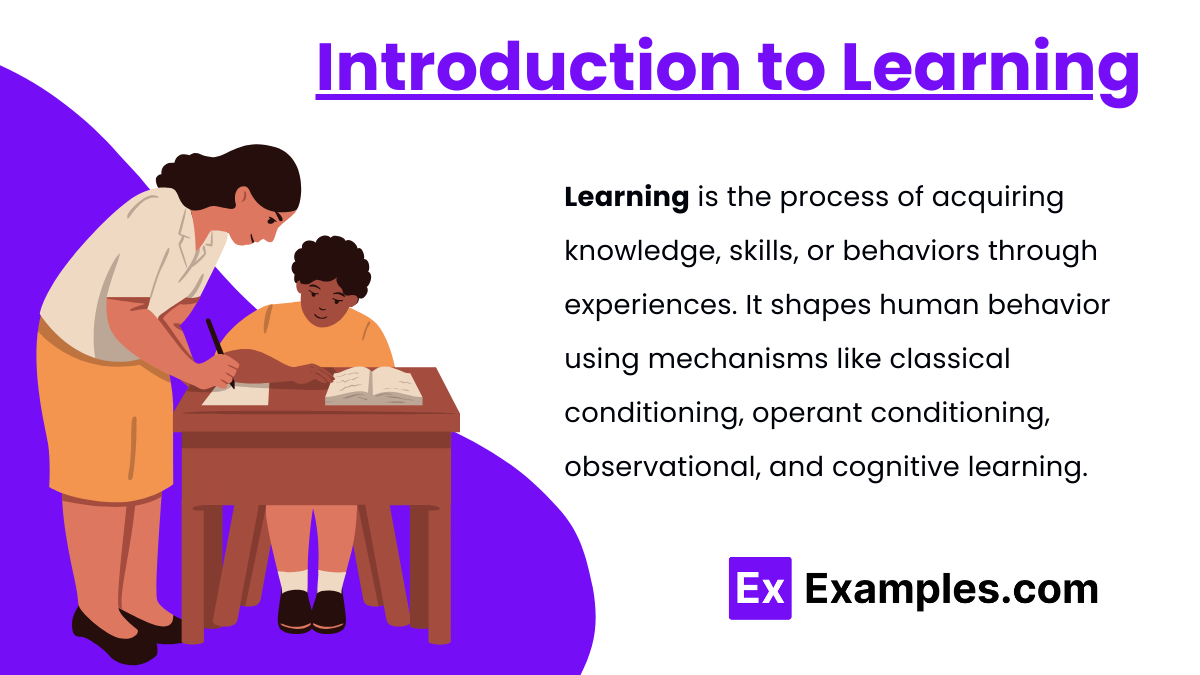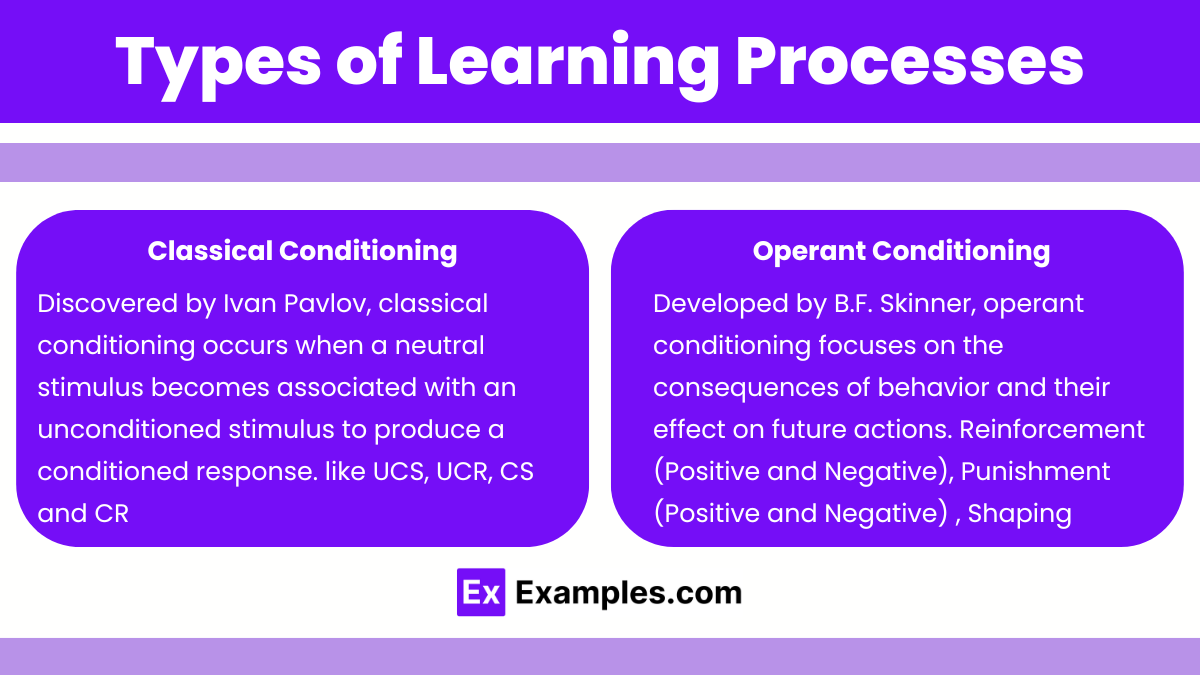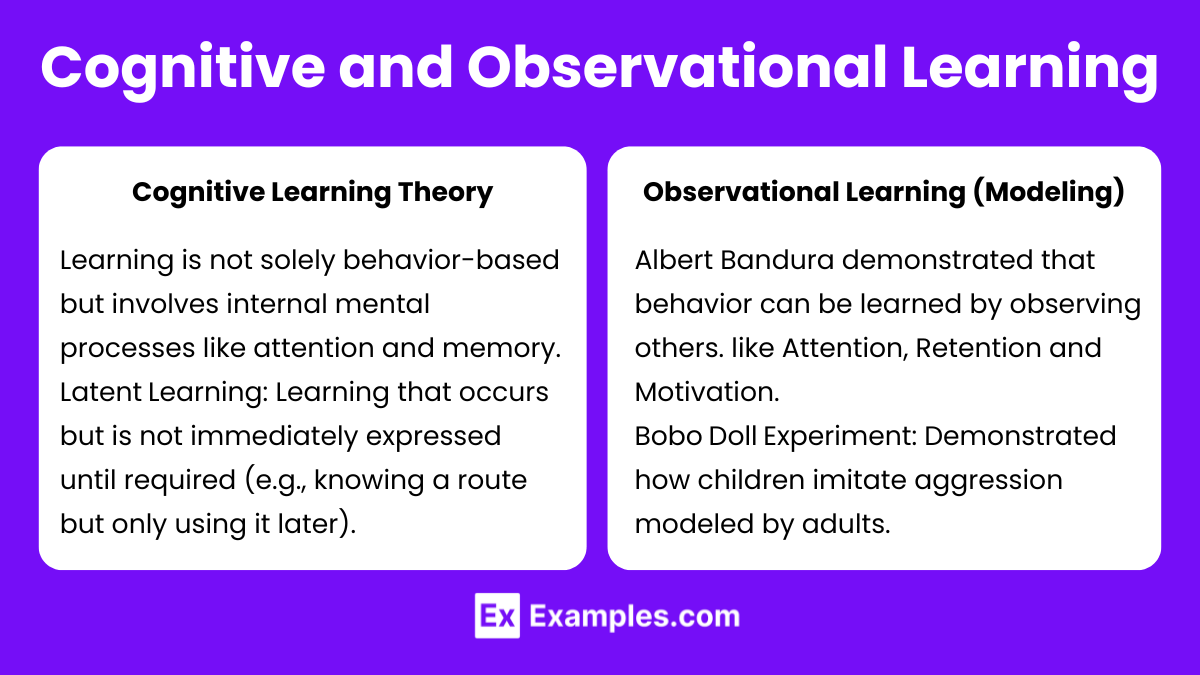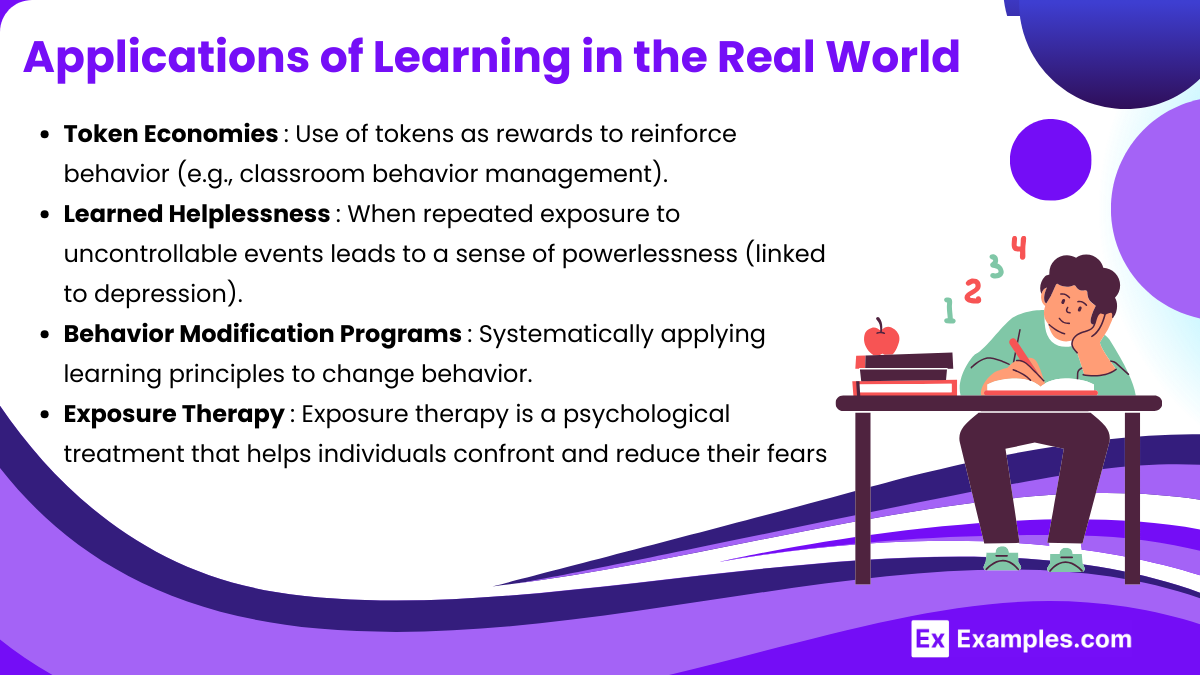Learning is a fundamental psychological process through which individuals acquire new knowledge, skills, and behaviors based on experiences. It involves mechanisms like classical conditioning, operant conditioning, and cognitive learning, which shape responses to environmental stimuli. Understanding learning theories is crucial for the MCAT, as it provides insight into how behavior is formed, maintained, or altered over time.
Learning Objectives
In studying "Learning" for the MCAT, you should understand the core theories, including classical conditioning, operant conditioning, and observational learning. Analyze how reinforcement, punishment, and extinction shape behaviors, and explore the cognitive processes involved in learning. Evaluate the role of biological constraints, such as preparedness and instinctive drift, in limiting or enhancing behavior acquisition. Study applications like token economies, behavior modification, learned helplessness, and exposure therapy in clinical and real-world settings. Apply your knowledge to interpret behavioral scenarios and experimental data accurately in MCAT practice passages, focusing on how learning principles influence human behavior and psychological outcomes.
Introduction to Learning

Learning is the process through which individuals acquire new knowledge, skills, behaviors, or attitudes based on experiences and interactions with the environment. It plays a vital role in shaping human behavior, from basic reflexes to complex cognitive patterns. Learning can occur through different mechanisms, including classical conditioning, operant conditioning, observational learning, and cognitive learning processes. Biological constraints, like instinctive drift and preparedness, influence how behaviors are acquired. Understanding these principles is essential for the MCAT, as they provide insight into behavioral patterns and their real-world applications in therapy, education, and habit formation.
Types of Learning Processes

Classical Conditioning (Pavlovian Conditioning)
Discovered by Ivan Pavlov, classical conditioning occurs when a neutral stimulus becomes associated with an unconditioned stimulus to produce a conditioned response.
Key Concepts:
Unconditioned Stimulus (UCS): Naturally triggers a response (e.g., food causing salivation).
Unconditioned Response (UCR): Natural response to UCS (e.g., salivating).
Conditioned Stimulus (CS): Previously neutral stimulus that elicits a response after association (e.g., bell ringing).
Conditioned Response (CR): Learned response to the conditioned stimulus (e.g., salivating at bell sound).
Operant Conditioning (Instrumental Learning)
Developed by B.F. Skinner, operant conditioning focuses on the consequences of behavior and their effect on future actions.
Key Components:
Reinforcement: Increases the likelihood of behavior repetition.
Positive Reinforcement: Adding a pleasant stimulus (e.g., reward).
Negative Reinforcement: Removing an unpleasant stimulus (e.g., stopping a loud noise).
Punishment: Decreases the likelihood of behavior repetition.
Positive Punishment: Adding an unpleasant stimulus (e.g., giving detention).
Negative Punishment: Removing a pleasant stimulus (e.g., taking away privileges).
Shaping: Gradually reinforcing closer approximations to the desired behavior.
Cognitive and Observational Learning

Cognitive Learning Theory
Learning is not solely behavior-based but involves internal mental processes like attention and memory.
Latent Learning: Learning that occurs but is not immediately expressed until required (e.g., knowing a route but only using it later).
Observational Learning (Modeling)
Albert Bandura demonstrated that behavior can be learned by observing others.
Key Concepts:
Attention: Paying attention to the model's behavior.
Retention: Remembering the observed behavior.
Reproduction: Reproducing the behavior later.
Motivation: The observer must have the desire to imitate the behavior.
Bobo Doll Experiment: Demonstrated how children imitate aggression modeled by adults.
Biological Constraints on Learning

Preparedness: Some behaviors are more easily learned due to biological predispositions (e.g., fear of snakes). Preparedness refers to the idea that organisms are biologically predisposed to learn certain types of behaviors more easily than others, often because these behaviors enhance survival. For example, humans and animals are more likely to develop phobias or fears toward stimuli that were historically dangerous, such as snakes or spiders, even when they have little direct experience with them.
Instinctive Drift: Animals may revert to instinctual behaviors, interfering with conditioned behaviors. Instinctive drift occurs when an animal’s learned behavior gradually reverts to innate, instinctual patterns, even when the behavior has been conditioned through operant techniques. This phenomenon reveals the limits of learned behaviors, especially when these behaviors conflict with natural instincts.
Applications of Learning in the Real World

Token Economies: Use of tokens as rewards to reinforce behavior (e.g., classroom behavior management).
Learned Helplessness: When repeated exposure to uncontrollable events leads to a sense of powerlessness (linked to depression).
Behavior Modification Programs: Systematically applying learning principles to change behavior (e.g., quitting smoking).
Exposure Therapy: Exposure therapy is a psychological treatment that helps individuals confront and reduce their fears or phobias through gradual exposure to the feared stimulus.
Cognitive Behavioral Therapy (CBT) : CBT applies learning principles to help individuals identify and change negative thought patterns and behaviors, using tools like reinforcement and cognitive restructuring.
Examples
Example 1: Classical Conditioning in Phobia Development
Classical conditioning explains how phobias develop through the association of a neutral stimulus with an anxiety-inducing one. For example, if a child is bitten by a dog (unconditioned stimulus), they may start associating all dogs (neutral stimulus) with fear (conditioned response). Even seeing a harmless dog may trigger anxiety after one negative experience. This principle is central in understanding the development and treatment of phobias.
Example 2: Operant Conditioning in Addiction Treatment
Operant conditioning is often used in addiction therapy, such as contingency management. Patients receive positive reinforcement, like gift vouchers or privileges, for staying drug-free. Negative behaviors (drug use) can also be discouraged with punishments, such as removing privileges. This system of rewards and punishments helps reinforce desired behaviors and reduce relapse rates.
Example 3: Observational Learning in Social Situations
Observational learning, or modeling, explains how individuals learn behaviors by watching others. For example, medical students learn bedside manners by observing experienced physicians interacting with patients. Similarly, children may learn social behaviors, both good and bad, by watching parents, teachers, or peers. This type of learning emphasizes the role of attention, retention, and motivation.
Example 4 : Cognitive Learning in Problem Solving
Cognitive learning involves acquiring knowledge and skills through mental processes rather than trial-and-error. For instance, students studying for the MCAT engage in cognitive learning when they apply strategies like concept mapping or retrieval practice. This approach emphasizes understanding over rote memorization, encouraging students to draw connections between different concepts.
Example 5: Habituation in Medical Practice
Habituation occurs when individuals become desensitized to a repeated stimulus over time. In healthcare settings, habituation can be seen in medical professionals who grow accustomed to stressful environments. For example, new nurses may initially feel overwhelmed by alarms in the ICU, but with repeated exposure, they learn to respond efficiently, focusing only on critical alarms and ignoring irrelevant ones.
Practice Questions
Question 1
Which of the following best exemplifies classical conditioning?
A) A student receives praise for answering questions correctly in class.
B) A person develops a fear of dogs after being bitten by one.
C) A rat learns to press a lever to receive food rewards.
D) A child imitates their parent's behavior after watching them.
Correct Answer: B) A person develops a fear of dogs after being bitten by one.
Explanation: Classical conditioning occurs when a previously neutral stimulus (e.g., a dog) becomes associated with an unconditioned stimulus (e.g., a bite) to produce a conditioned response (fear). After this association, the person may experience fear just by encountering a dog, even without being bitten again. This process involves pairing stimuli to elicit automatic responses, typical of Pavlov’s classical conditioning framework. Options A and C are examples of operant conditioning, while option D refers to observational learning.
Question 2
In operant conditioning, which of the following is an example of negative reinforcement?
A) Giving a child a candy for cleaning their room.
B) Scolding a child to stop them from drawing on walls.
C) Taking away a child’s chores for completing homework.
D) Removing a child’s video game for failing a test.
Correct Answer: C) Taking away a child’s chores for completing homework.
Explanation: Negative reinforcement involves removing an unpleasant stimulus to increase the likelihood of a desired behavior. In this example, the unpleasant stimulus (chores) is removed to encourage the behavior (completing homework). Option A is positive reinforcement, which involves adding a reward. Option B is positive punishment (adding a scolding), and option D is negative punishment (removing a privilege to discourage a behavior).
Question 3
Which concept explains why individuals may stop trying to escape negative situations after repeated failed attempts?
A) Token Economy
B) Observational Learning
C) Learned Helplessness
D) Shaping
Correct Answer: C) Learned Helplessness
Explanation: Learned helplessness occurs when an individual experiences repeated failures or uncontrollable negative outcomes and begins to believe that they are powerless to change their circumstances. This concept is often linked to mental health issues, like depression. Token economy (A) involves using rewards to reinforce behavior, observational learning (B) is learning through watching others, and shaping (D) refers to reinforcing successive approximations toward a desired behavior.


